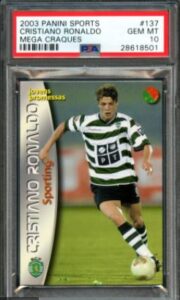
Card grading is a popular practice that’s become a big part of the sports card hobby.
There are plenty of reasons why card grading is a good idea – For example, it protects and preserves the card’s condition, once it’s been slabbed, but can also increase the value in most cases.
So here is everything you need to know about sports card grading for beginners.
Table of Contents
What Is Card Grading?
Card grading is the process of having a ‘raw’ (ungraded) trading card inspected for any wear and tear (on both front and back), by a professional/expert grader, who typically gives it a score from 1-10 based on its condition, with 10 being mint condition.
The card will then be carefully encased in a hard plastic cover with its details and grade on the label at the top.
For any cards that include them, many grading companies also give an autograph a separate grade, which will also be included on the label next to the main grade.

During grading, a card’s condition is judged on the following areas:

Surfaces
The surface is assessed for coloring and any scratches, scuffs, dents, lines or tears, plus any printing defects.
A card’s surface is prone to fingerprints, which can be helped, and depending on the material of the card, removed. Discoloration is another common surface issue, which can’t be reversed.
A card that is perfect in all other areas, but has some surface issues, will not achieve top grades, so it’s important to store sports cards correctly and protect them before starting the grading process.
Centering
Centering of the card’s artwork is evaluated as well – the symmetry of the edges is measured on the front and back, a perfectly centered card should have evenly measured borders. Sometimes cards are printed off center.
It’s an area that isn’t important to some collectors, and overlooked by many new collectors, but for grading companies, it very much is an important factor in the grading process.
A card won’t be considered to be pristine or mint condition if the centering is out, no matter how little physical damage there is.
When you’ve been around the hobby for long enough, and you’ve seen enough cards, you start to develop an eye for centering, and the ability to spot card art that isn’t symmetrical.
Here’s an example of an off-centered Mickey Mantle card, if you look closely at the borders on either side, they’re not even:
Corners
The corners and edging are looked at for any whitening, discoloration and scuffs as well as the corner symmetry.
A card in top condition will have perfectly sharp corners with no sign of wear and tear, a slight imperfection to any one of a card’s corners will have a detrimental effect to its potential grade.
Edges
A mint condition card should have sharp edges with no signs of damage – Edges can be damaged by just handling a card incorrectly.
You often see whitening on darker cardboard cards that are older, but sometimes it’s not as obvious; Graders will use tools like a magnifying glass to spot any imperfections.
Here’s an example of a Michael Jordan card with slight damage to the edges and corners:
What Is A Raw Sports Card?
A ‘raw’ card is essentially a non-graded card. They’re usually lower in value because the condition of the card hasn’t been professionally evaluated – The described condition of an ungraded card would be the opinion or prediction of the cardholder, and not a neutral third party.
What Card Grading Services Should You Use?
If you’re unsure who grades cards, collectors have the choice of multiple established grading services – The most established and popular trading card grading companies are:
PSA Grading
PSA are the most well-known and popular grading company, they’ve been grading cards for many years, and they’re certainly the most-used option for modern trading cards, and their label is instantly recognizable and generally trusted.
Beckett Grading
Beckett are another popular and very well-known option, and they have arguably the most in-depth and accurate card grading, with sub-grades included and their coveted and prestigious black label pristine 10 grade.
SGC Grading
SGC have been around for a long time, and are generally the go-to grading company for vintage cards, but also a popular option for modern cards. Their simple label design resonates well, and they’re cheaper and faster than PSA grading and Beckett grading.
There are alternatives that you can use, which have their own pros, check out our full beginner’s guide to the best services.
Helpful Resources:
Grading Scales
Grading services have their own grading scales, with their own definitions, but they’re generally similar, here’s a look at the 3 companies I mentioned above, and their grading scales.
PSA Grading Scale
PSA’s grading scale goes from 1 (poor) to 10 (gem mint), with an additional ‘Authentic’ grade for cards that are below a 1.
BGS Grading Scale
BGS’ grading scale goes from 1 (poor) to 10 (pristine), including half points and sub-grades. They also have a separate scale for autographs, which runs 5 through 10.
SGC Grading Scale
SGC’s grading scale goes from 1 (poor) to 10 (pristine).
How Do You Get Sports Cards Graded?
So, if you have a sports card collection that you’d like to get graded, how do you go about doing that?
Well, first it’s a case of picking the grading company you want to go with.
Once you’ve decided which grading service to use, visit their website and start the submission process.
For PSA it can be started here, for Beckett it’s here, and for SGC it’s here.
There are different services to choose from based on the value of the card and the time it takes to grade, PSA, BGS, SGC and most other grading companies have multiple service levels – details, guidelines and pricing are made clear during the submission process.
You also need to clean and prepare the card for submission. Then, I’d recommend putting the card carefully into a card sleeve and then a semi-rigid cardholder.
It’s also a good idea to stick an index tag to the card sleeve before putting it into the cardholder so it can be removed for grading easier. It’s important to safely ship your cards in the mail when submitting them for grading, to avoid damage.
The Process
Step 1 – Decide which cards to submit for grading.
Step 2 – Pick the grading company and service level.
Step 3 – Submit your cards via their website.
Step 4 – Prepare and package your cards for shipping.
Step 5 – Send cards for grading.
Step 6 – Receive your newly graded cards back in the mail.
How Much Does Card Grading Cost?
The cost of having a card graded depends on a few different factors, which include:
- The Grading company you use to grade your cards.
- The Service level you pick (turnaround time and value of card).
- The level of postage and insurance you pick.
- How many cards you submit.
All of those factors listed above have an impact on how much it’ll cost, per card, to grade – Not to mention that grading companies regularly change their pricing depending on demand.
You should expect to pay a minimum of around $15 per card for professional card grading. For an accurate, and up-to-date, service level pricing guide for all major grading companies, take a look at our separate post here.
The Cheapest Way To Get Cards Graded
You can get sports cards graded for as cheap as $12 per card, with ISA grading.
If you want to go with one of the top grading services, PSA does offer a $14.99 per card bulk service (min 20 cards), for cards valued at $200 or less.
How Long Does It Take To Grade Cards?
The wait to get cards graded is dependent on demand, which is always high for the most popular companies. Interest in collectible cards and grading them has ups and downs, like any hobby, so it’s impossible to say exactly how long you’ll have to wait at any current time – But, you’ll generally be waiting at least a few months to complete the whole process.
The service level you opt for also has an impact on turnaround time – Most grading companies offer a more expensive service, which has reduced turnaround times.
There’s usually an updated turnaround time estimate you can check on their site.
If turnaround time is important to you, then there’s grading service options that will be a lot faster than PSA, for example, but the grade probably won’t hold the same weight or value that a PSA label does, so consider that factor when looking at the alternative grading companies.
Is Card Grading Worth It?
The cost of grading a sports card is by no means cheap, so is it worth it?
Graded cards are worth more than raw cards because their condition has been analyzed and authenticated by an expert, but that doesn’t necessarily mean you should get every trading card you own graded.
If you’re a collector who wants cards graded for your personal collection, then sure, go ahead and get them graded – But if you’re grading sports cards because you want to add resale value, you have to decide which cards are worth grading.
Firstly, try and estimate what you’d expect the card to be graded at based on the areas I mentioned above, make sure to evaluate the condition on both the front and back of the cards.
I’d always recommend being conservative when estimating a card’s grade as it’s likely you’ll be over generous, it’s hard for a card to achieve mint condition status – Centering is often overlooked by beginners.
Once you have a rough estimate, search the current population report of that graded card – if there’s a huge supply of it already, then it’s less likely to hold value. I would then check the current value of the card in the grade you’re expecting (I’d also check one grade up and one grade down) using eBay’s completed and sold items filter or PSA auction prices.
Also think about the desirability of the cards, if they’re sought-after rookie cards, for example, it’s probably worth grading, especially if it’s likely to achieve a high grade.
Once you’ve done that research, you can consider if the cost of grading (as well as the wait time) is worth it, in other words, does grading the card you own increase the value enough to make it worthwhile?
Can You Get A Sports Card Graded In-Person?
You can get cards graded in-person, but it’s worth noting it can be expensive. It also depends on where you live in the US.
You can’t currently take your sports cards to a card grading company‘s offices and expect in-person grading to be done, and they don’t have a shop to visit.
However, there are opportunities to have sports cards graded in-person, mainly at card shows – PSA and Beckett, for example, will usually announce which shows they’ll offer in-person grading at, so depending on how close you live to one of those shows, that’s potentially a better option than shipping cards for the usual process.
The big benefit is obviously getting cards graded a lot quicker, and you don’t need to worry about any issues with the card being shipped.
It’s worth contacting your chosen grading company’s customer service team as a first step if you need a card graded in-person.
Helpful Resource:
How To Grade Cards In Europe
The biggest and most popular grading services are all based in the US, so it’s not as easy to get your cards graded if you live in Europe.
However, you can still submit your cards to PSA, BGS, SGC or any of the other major companies, as you would if you lived in the US – you just have to expect longer turnaround times, because you’ll need to ship the cards over.
At the moment, the major grading companies haven’t really expanded overseas and so there’s not currently the option for collectors based in Europe to ship locally.
It’s important to correctly protect your cards if you’re shipping overseas to avoid damage, and I would also recommend spending a little extra to ensure your cards are tracked and insured when you ship them.
Other Helpful Sportscardspecialist Card Grading Guides
Take a look at some of our other card grading related articles below:
- The Best Card Grading Companies
- How Much Does It Cost To Get A Card Graded?
- How To Know Which Cards Are Worth Grading
- Why Is Grading Expensive And Is It Worth It?
- How To Clean A Card For Grading
- How To Become A Professional Card Grader
- Do PSA And BGS Accept Top Loaders For Grading?
- Where To Get Cards Graded In-Person
- How To Safely Ship Cards For Grading
- When Does PSA, BGS And SGC Charge You For Grading?


